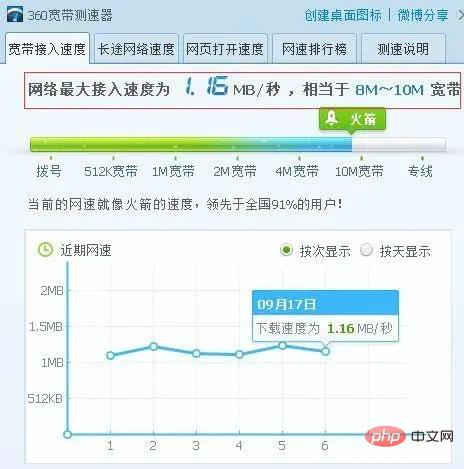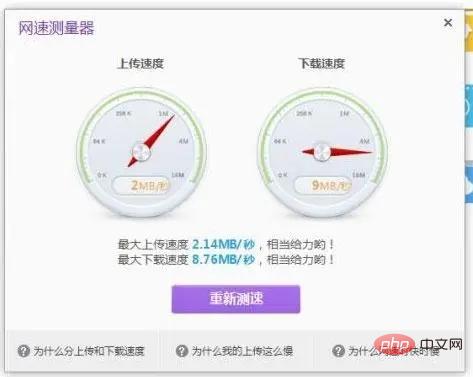200mbps is how many megabits of broadband?
200mbps is 200 megabit broadband. The so-called broadband 200Mbit actually means that the broadband access rate is 200Mbit; because "1Mbps = 1024kbps = 1024/8 KBps = 128KB/s", if converted, the download speed of 200M broadband is: "200 * 128 KB/ s = 25600 KB/s = 25600 / 1024 MB/s = 25.6MB/s”.

The operating environment of this tutorial: Windows 7 system, Dell G3 computer.
200Mbps means a transmission speed of 200 megabytes per second. 200mbps is 200 megabytes.
The so-called broadband 200Mbit actually means that the speed of the broadband access is 200Mbps, where 200Mbps refers to 200Mbps, and the unit is "bits". It does not refer to the network where files are downloaded in daily life. Speed unit "bytes".

The theoretical maximum download speed of 200MB is 25.6MB/s. 2, 4, and 8 Mbps in broadband network speeds usually refer to 2, 4, and 8 Mbps. bps (bits-persecond), that is, bit rate, bits/second, bits/second, bits transmitted per second, a common unit of data transmission rate.
b is actually bits, that is, bit, and the full English name of B is Byte (byte). Their conversion relationship is: 1Byte=8 bits

There is a conversion relationship, then the problem of broadband bandwidth is easily solved:
1Mbps = 1024kbps = 1024/8 KBps = 128KB/s
In other words, if your home has a 1M broadband, then The actual download speed theoretical value is 128KB, then the download speed of 200M broadband is: 200 * 128 KB/s = 25600 KB/s = 25600 / 1024 MB/s = 25.6MB/s,
So 200M broadband The theoretical maximum download speed of broadband is only 25.6MB/s. That is to say, if you are not restricted by any server or your own equipment bottleneck, your download speed will be 25.6MB, not 200MB.
After understanding the above formula, a quick calculation method for the actual download speed is: bandwidth ÷ 8 = maximum download speed.
About the uplink and downlink rates.
In the past, when the network was relatively slow, operators provided broadband to users, such as 10Mbps broadband. The operator would set the uplink and downlink to 10Mbps. Later, as broadband became more and more popular, Quickly, when the operator increased the broadband speed of Lao Zhang's home to 20Mbps, the uplink speed was still 10Mbps, but the downlink speed was increased to 20Mbps. Later, the downlink speed was increased to 200Mbps, and the uplink speed was still 10Mbps. This approach has been criticized by many people. In fact, this is not only a trick of the operators, but also a last resort.

Let’s talk about upstream and downstream first. When we usually go online and visit a web page, only when you enter the URL and submit it, it is the upstream data. Submit your needs to the server, and then The process of opening a web page is downloading, and the server's data is downloaded to your browser. If you are downloading a file, except for a small amount of upward movement at the beginning, the rest is downward. This is a broad concept. In fact, there is always a small amount of uplink data in this process, which is negligible compared to the large bandwidth.
There are several reasons why operators limit the uplink rate: first, to save limited bandwidth, which can be regarded as maximizing resources; second, to prevent someone from using high-speed home broadband for commercial purposes. As we all know, the broadband provided by China Unicom to enterprises is priced at 3,000 yuan per month for 100M. Compared with the part-time home broadband, the difference is more than ten times. Some small businesses have opened up home broadband and used it in the office, which can be regarded as a benefit. Operator's loophole. In order to prevent this phenomenon from happening, it is necessary to limit the uplink bandwidth, which is also a last resort. Third, users do not have a large demand for uplink, and the impact after the restriction will not be too great.
After limiting the uplink, there are several impacts: First, the video chat may be stuck, but with the current 10Mbps uplink, it is basically smooth, so as long as no one is uploading things at the same time, Generally not aware of it. Second, the speed of uploading files to the network disk is limited. Many people like to put large files in network disks. It is really uncomfortable to see the pitiful 1MB/s when uploading.

Nowadays, many operators' contracts have clearly stated that the downlink bandwidth is 100Mbps, and some even specify that the uplink bandwidth is 10Mbps, which can be regarded as a clear price tag. If you don’t feel comfortable with the upside, just spend more money on enterprise broadband.
Bandwidth is limited by many factors.
If this problem is clarified, but the so-called speed is still not achieved, there are many reasons. We have written a special article to discuss this, so we will not go into detail today. For example, switches, routers, network cables, network cards, and optical modems may all have bottleneck restrictions that prevent the 200M bandwidth from being reached.
In addition, the servers you visit also have certain restrictions.
For example, when we download something from a certain website, the website server may have an outlet of 10M, so you can only reach its maximum value.
For example, when we download something from a certain network disk, the network disk may have restrictions. Unless you are a gold member who spends money, you can achieve the highest download rate.
These things are like a highway, from city A to city B. Along the way, there must be enough lanes, enough bridges, and enough entrances and exits, so that you can speed all the way. If the bridge on a certain section has only one lane, the speed will be stuck here.
For more related knowledge, please visit the FAQ column!
The above is the detailed content of 200mbps is how many megabits of broadband?. For more information, please follow other related articles on the PHP Chinese website!

Hot AI Tools

Undresser.AI Undress
AI-powered app for creating realistic nude photos

AI Clothes Remover
Online AI tool for removing clothes from photos.

Undress AI Tool
Undress images for free

Clothoff.io
AI clothes remover

AI Hentai Generator
Generate AI Hentai for free.

Hot Article

Hot Tools

Notepad++7.3.1
Easy-to-use and free code editor

SublimeText3 Chinese version
Chinese version, very easy to use

Zend Studio 13.0.1
Powerful PHP integrated development environment

Dreamweaver CS6
Visual web development tools

SublimeText3 Mac version
God-level code editing software (SublimeText3)

Hot Topics
 1378
1378
 52
52
 What is the actual speed of 600m broadband?
Mar 15, 2023 pm 02:57 PM
What is the actual speed of 600m broadband?
Mar 15, 2023 pm 02:57 PM
The actual network speed of 600m broadband is about 60M-70M per second. 600M refers to 600 megabits (Mpbs) broadband, converted into data transmission speed in bytes: 1Mbps=1/8MBps, then the download speed of 600 megabits broadband is "600÷8=75MB/s", that is, per second 75MB download speed; but this data is only a theoretical download speed. In fact, broadband download speed is affected by many factors, such as router network transmission channel and network delay issues. Generally, the actual network speed is around 60M-70M per second.
 What is the difference between Ethernet and Broadband?
Dec 08, 2020 pm 02:28 PM
What is the difference between Ethernet and Broadband?
Dec 08, 2020 pm 02:28 PM
Difference: Ethernet is the most common communication protocol standard used in existing local area networks today. Ethernet transmits information packets at a rate of 10-100Mbps between interconnected devices; broadband is not strictly defined, and is generally demarcated by 56Kbps. Access methods of 56Kbps and below are called "narrowband", and access methods above are classified as "broadband".
 What is the uplink and downlink of 1000M broadband?
Oct 28, 2022 am 11:02 AM
What is the uplink and downlink of 1000M broadband?
Oct 28, 2022 am 11:02 AM
The downlink rate of 1000M broadband is 1000 Mbps, and the uplink rate is 30 Mbps; but to be precise, the uplink rate is not certain, because ordinary users have limited uplink rates, which are related to the local operator who handles the broadband; generally, if it is dedicated line broadband, Then the uplink rate and downlink rate are equal.
 200mbps is how many megabits of broadband?
Mar 20, 2023 pm 02:21 PM
200mbps is how many megabits of broadband?
Mar 20, 2023 pm 02:21 PM
200mbps is 200 megabit broadband. The so-called broadband 200Mbit actually means that the broadband access rate is 200Mbit; because "1Mbps = 1024kbps = 1024/8 KBps = 128KB/s", if converted, the download speed of 200M broadband is: "200 * 128 KB/ s = 25600 KB/s = 25600 / 1024 MB/s = 25.6MB/s”.
 How many megabytes of broadband is 30mb/s?
Mar 20, 2023 am 11:18 AM
How many megabytes of broadband is 30mb/s?
Mar 20, 2023 am 11:18 AM
30mb/s is approximately 240 megabytes of broadband, and the conversion formula is "30MB/Sx8=240M"; usually the megabyte of file size refers to 4MByte; byte (Byte) is a measurement used by computer information technology to measure storage capacity. Units that also represent data types and language characters in some computer programming languages.
 1mbps equals how many mb/s
Feb 22, 2023 am 11:05 AM
1mbps equals how many mb/s
Feb 22, 2023 am 11:05 AM
1Mbps is theoretically equal to 0.125MB/s. Mbps is a unit of transmission rate, which refers to the number of bits (bits) transmitted per second; 1Mbps represents the transmission of 1,000,000 bits (bits) per second, that is, the amount of data transmitted per second is "1000000/8=125000Byte/s", converted into The commonly used MB unit is "100Mbps=100/8=12.5MB/s", that is, "1Mbps=1/8=0.125MB/s".
 What is the difference between campus network and broadband?
Sep 20, 2023 pm 05:27 PM
What is the difference between campus network and broadband?
Sep 20, 2023 pm 05:27 PM
The differences between campus network and broadband are in terms of usage scenarios and network range, speed and bandwidth, service providers, usage restrictions and service content. Detailed introduction: 1. Usage scenarios and network scope. Campus network is a local area network service provided within schools, universities or educational institutions. It mainly covers the school’s teaching buildings, dormitory buildings and other areas, and provides network connection services for students, faculty and staff. Usually built and managed by the school itself, it provides specific network resources and services. Broadband is a wide area network service that provides high-speed Internet connections for individual users or families, etc.
 What does broadband relocation mean?
Oct 27, 2022 pm 03:00 PM
What does broadband relocation mean?
Oct 27, 2022 pm 03:00 PM
Broadband relocation means that when the customer's installed broadband needs to be moved to a new installation address, the customer submits an application for the relocation service to the telecommunications company. The telecommunications company will promptly relocate the broadband business address for the customer based on the customer's requirements and resource conditions; the household owner only needs Just bring your ID card to the local business office to handle the relocation service.



